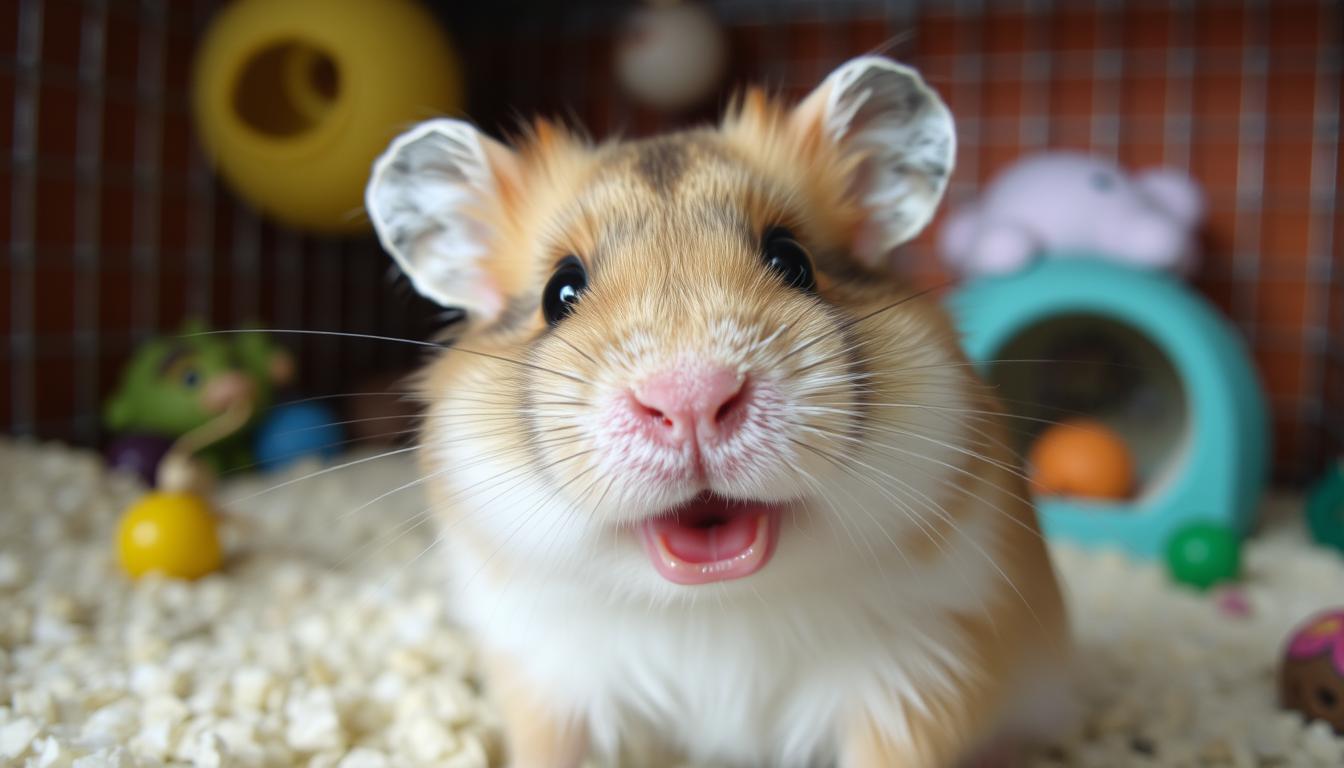Hamsters. Those adorable, cheek-stuffing, wheel-running balls of fluff. We love them for their quirky personalities and their ability to find snacks in the most improbable places. But beneath that fluffy exterior lies a set of constantly growing teeth that require a little bit of attention from their human companions. So, the big question: do you need to cut your hamster’s teeth? The answer isn’t a simple yes or no, but rather a "it depends." Let’s dive into the world of hamster dentition and explore what you need to know to keep your little friend’s chompers in tip-top shape. Because trust us, a hamster with dental issues is one unhappy hamster. And nobody wants that!
Hamster Teeth: Are They a Never-Ending Story of Growth?
Yes, you read that right! Hamster teeth are indeed a never-ending story of growth. Unlike our own teeth, which stop growing once we reach adulthood, a hamster’s incisors (those two prominent front teeth on both the upper and lower jaw) are open-rooted. This means they continuously erupt throughout their life. This constant growth is necessary because, in the wild, hamsters would be gnawing on tough roots, seeds, and other abrasive materials, naturally wearing down their teeth. Think of it like a self-sharpening blade, constantly being used and refined.
This continuous growth is a key aspect of hamster biology, perfectly adapted to their natural foraging and feeding habits. Imagine if their teeth stopped growing – they would quickly wear down to nothing! This adaptation is what allows them to tackle a variety of foods and materials in their environment. It’s a fascinating example of how nature equips animals for survival.
However, this constant growth also means that pet hamsters, who often have access to softer foods and don’t engage in the same level of gnawing as their wild counterparts, can sometimes experience dental problems. Without sufficient wear, their teeth can become overgrown, leading to discomfort and difficulty eating.
Therefore, understanding the continuous growth of hamster teeth is the first step in ensuring their dental health. It highlights the need for providing them with appropriate chew toys and monitoring their teeth regularly for any signs of overgrowth or misalignment. A proactive approach is key to keeping those chompers healthy and happy.
So, while the idea of never-ending teeth might seem a bit daunting, remember that with the right care and attention, you can help your hamster maintain a healthy and functional set of teeth throughout their life. Think of it as an ongoing partnership in dental hygiene!
And don’t worry, you don’t need to enroll in dental school. Just a little awareness and some simple preventative measures can go a long way in keeping your hamster’s teeth in check. Now, let’s move on to recognizing the signs of overgrown teeth.
Uh Oh, Long Teeth? Spotting the Signs of Overgrowth in Hamsters
Okay, so you know hamster teeth grow continuously. But how do you know if they’re growing too much? Spotting the signs of overgrowth is crucial for preventing serious dental problems. One of the most obvious signs is difficulty eating. If your hamster is dropping food, struggling to pick it up, or showing a decreased appetite, overgrown teeth could be the culprit. They might also be picking at their food, showing interest but then quickly giving up.
Another telltale sign is weight loss. If your hamster is unable to eat properly due to overgrown teeth, they’ll inevitably start losing weight. This can be a gradual process, so it’s important to monitor their weight regularly, especially if you suspect dental issues. A sudden or significant drop in weight is a red flag that warrants a vet visit.
Keep an eye out for excessive drooling. Overgrown teeth can irritate the gums and cause excessive saliva production. You might notice wetness around your hamster’s mouth and chin. This isn’t normal and should be investigated. Similarly, check for any signs of bleeding around the mouth or gums.
Behavioral changes can also indicate dental problems. A usually active and playful hamster might become lethargic and withdrawn. They might also start pawing at their face or rubbing their mouth against objects in their cage, trying to relieve the discomfort. Irritability and aggression can also be signs of pain.
Finally, take a peek at their teeth! If you can safely and gently examine your hamster’s incisors, look for excessive length, misalignment, or unusual angles. The teeth should meet evenly and not be overly long. If you notice anything unusual, it’s time to consult with a veterinarian. Remember, early detection is key to preventing more serious complications.
Chew Toys to the Rescue: Natural Ways to Keep Teeth Trimmed
Thankfully, you don’t always need to resort to drastic measures like tooth trimming. Often, providing the right chew toys can help your hamster naturally wear down their teeth. Think of it as a DIY dental plan, hamster-style! But what kind of chew toys are best?
Wooden chew toys are a great option. Look for untreated, kiln-dried wood that is safe for hamsters to gnaw on. Avoid wood that has been painted, stained, or treated with chemicals, as these can be toxic. Fruit tree branches, like apple or pear, are often a good choice, but make sure they are thoroughly cleaned and dried before giving them to your hamster.
Cardboard is another safe and readily available chew toy. Empty toilet paper rolls or cardboard boxes can provide hours of entertainment and help wear down those teeth. Just make sure to remove any tape, glue, or staples before giving them to your hamster. Avoid glossy or heavily printed cardboard, as the inks can be harmful.
Commercial hamster chews, available at most pet stores, are specifically designed to promote dental health. Look for chews made from natural materials, such as wood, hay, or vegetable-based ingredients. Avoid chews that are high in sugar or artificial additives.
Hard, plain dog biscuits (without added flavors or chemicals) can also be offered in moderation. These can provide a good source of calcium and help wear down the teeth. However, don’t overdo it, as they can be high in calories.
Finally, consider providing a mineral or salt lick. These can help supplement your hamster’s diet and provide them with something to gnaw on. However, be sure to choose a lick that is specifically formulated for hamsters and doesn’t contain excessive amounts of salt or other minerals.
Remember to rotate your hamster’s chew toys regularly to keep them interested and engaged. Providing a variety of textures and materials will encourage them to gnaw and help keep their teeth in good shape.
When "Chew Time" Isn’t Enough: Recognizing Dental Problems
While chew toys are a great preventative measure, sometimes they’re simply not enough to keep a hamster’s teeth in check. Certain dental problems can prevent hamsters from effectively using chew toys, leading to overgrowth despite your best efforts. One common issue is malocclusion, where the upper and lower teeth don’t align properly. This can prevent the teeth from wearing down evenly, leading to uneven growth and difficulty eating.
Another potential problem is injury. A fall or a bump against the cage can damage a hamster’s teeth, causing them to break or become misaligned. This can lead to pain and difficulty eating, and can also exacerbate overgrowth. Check your hamster’s cage for any potential hazards that could cause injury.
Abscesses can also develop in the mouth, often as a result of overgrown teeth irritating the gums. These infections can be painful and can make it difficult for your hamster to eat. You might notice swelling around the mouth or face, or a discharge from the mouth.
Genetic factors can also play a role in dental problems. Some hamsters are simply predisposed to developing overgrown teeth or malocclusion. If you have a hamster with a history of dental problems, you’ll need to be extra vigilant about monitoring their teeth.
Finally, age can also contribute to dental issues. As hamsters get older, their teeth may become more brittle and prone to breakage. They may also be less able to effectively use chew toys. Older hamsters may require more frequent dental check-ups and may need to be fed softer foods.
If you suspect that your hamster is experiencing dental problems, it’s important to consult with a veterinarian as soon as possible. Early diagnosis and treatment can help prevent more serious complications and improve your hamster’s quality of life. Don’t hesitate to seek professional help if you’re concerned about your hamster’s dental health.
Hamster Tooth Trimming 101: Should You DIY or See a Vet?
So, your hamster’s teeth are overgrown despite your best efforts with chew toys. Now what? The question of whether to trim your hamster’s teeth yourself or take them to a vet is a crucial one, and the answer largely depends on your experience, comfort level, and the severity of the overgrowth.
Generally speaking, it’s highly recommended to have a veterinarian perform tooth trimming. Vets have the proper tools, training, and experience to safely and effectively trim a hamster’s teeth. They can also identify and address any underlying dental problems that may be contributing to the overgrowth.
However, in some very specific and minor cases, and only if you have been properly trained by a veterinarian, you might consider trimming your hamster’s teeth at home. This would typically involve using specialized nail clippers or small wire cutters designed for small animals. But again, this is a risky proposition and should only be undertaken with extreme caution.
If you’re considering DIY trimming, ask yourself these questions: Are you comfortable handling your hamster and keeping them still? Do you have the proper tools? Are you confident in your ability to trim the teeth without causing

